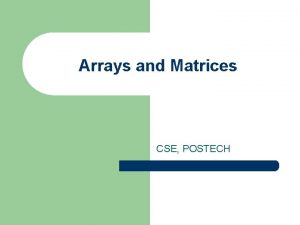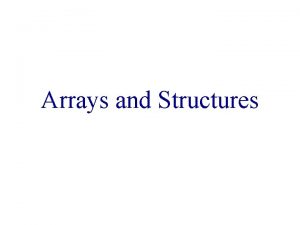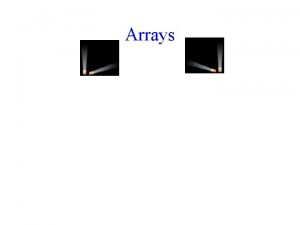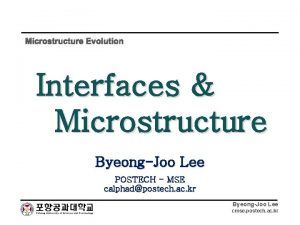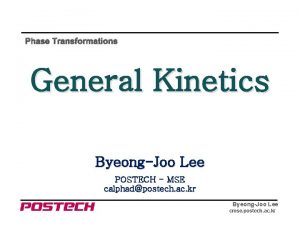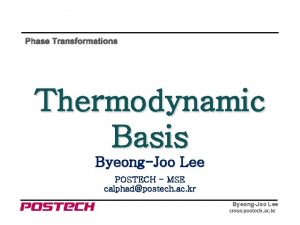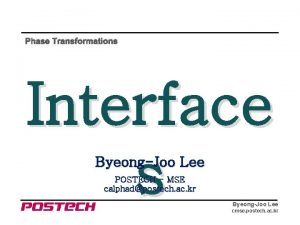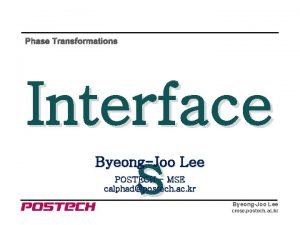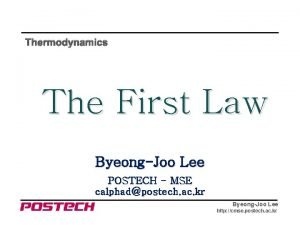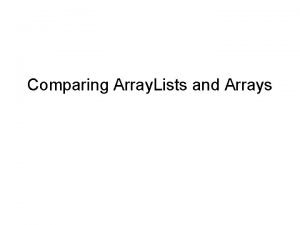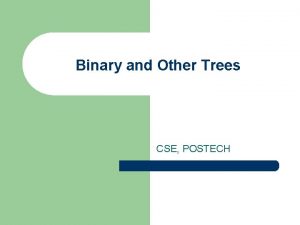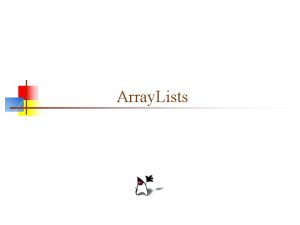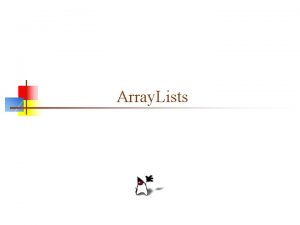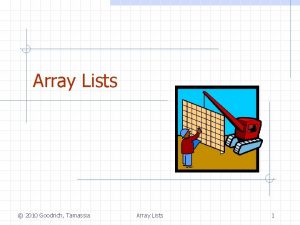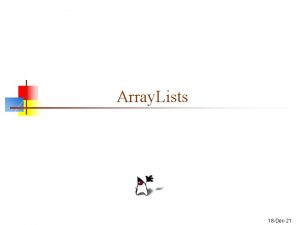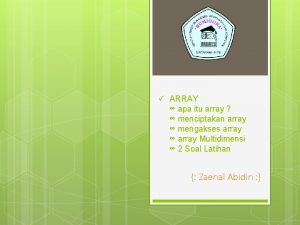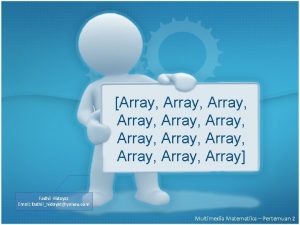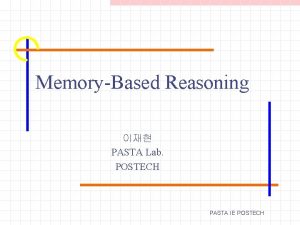Linear Lists Array Representation CSE POSTECH Introduction l

















- Slides: 17

Linear Lists – Array Representation CSE, POSTECH

Introduction l Data Object – – a set of instances or values Examples: l l – – 2 Boolean = {false, true} Digit = {0, 1, 2, 3, 4, 5, 6, 7, 8, 9} Letter = {A, B, C, …, Z, a, b, c, …, z} String = {a, b, …, aa, ab, ac, …} An individual instance is either primitive or composite. An element is the individual component of a composite instance.

Introduction l Data Structure – – – 3 data object together with the relationships among instances and elements that comprise an instance Among instances of integer 369 < 370 280+4 = 284 Among elements that comprise an instance 369 3 is more significant than 6 3 is immediately to the left of 6 9 is immediately to the right of 6

Introduction l Abstract Data Type (ADT) – – 4 ADT is a collection of data and a set of operations that can be performed on the data. It enables us to think abstractly about the data … We can separate concepts from implementation. Typically, we choose a data structure and algorithms that provide an implementation of an ADT.

Linear List l Definitions – – – l Examples – – 5 Linear list is a data object whose instances are of the form (e 1, e 2, …, en) ei is an element of the list. e 1 is the first element, and en is the last element. n is the length of the list. When n = 0, it is called an empty list. e 1 comes before e 2, e 2 comes before e 3, and so on. student names order by their alphabets a list of exam scores sorted by descending order

ADT for Linear List Abstract. Data. Type Linear. List { instances ordered finite collections of zero or more elements operations Create(): create an empty linear list Destroy(): erase the list Is. Empty(): return true if empty, false otherwise Length(): return the list size Find(k, x): return the kth element of the list in x Search(x): return the position of x in the list Delete(k, x): delete the kth element and return it in x Insert(k, x): insert x just after the kth element Output(out): put the list into the output stream out } 6

Implementations of Linear List l Array-based (Formula-based) – l Linked list (Pointer-based) – – l – The elements of a list may be stored in any arbitrary set of locations Maintain a table such that the ith table entry tells us where the ith element is stored Simulated pointer – 7 The elements of a list may be stored in any arbitrary set of locations Each element has an explicit pointer (or link) to the next element Indirect addressing – l Uses a mathematical formula to determine where (i. e. , the memory address) to store each element of a list Similar to linked representation but integers replace the C++ pointers

Array-based Representation of Linear List l l l It uses an array to store the elements of linear list. Individual element is located in the array using a mathematical formula. typical formula location(i) = i – 1 ith element of the list is in position i-1 of the array element [0] [1] [2] [3] [4] 5 2 4 8 Max. Size-1 1 length=5 l 8 See Figure 5. 1 for different ways to store

Array-based Class ‘Linear. List’ template <class T> class Linear. List { public: Linear. List(int Max. List. Size = 10); ~Linear. List() { delete [] element; } bool is. Empty() const { return length == 0; } int Length() const { return length; } bool Find(int k, T& x) const; int Search(const T& x) const; Linear. List<T>& Delete(int k, T& x); Linear. List<T>& Insert(int k, const T& x); void Output(ostream& out) const; private: int length; int Max. Size; T *element; }; 9

Constructor ‘Linear. List’ template<class T> Linear. List<T>: : Linear. List(int Max. List. Size) { // Constructor for array-based linear list Max. Size = Max. List. Size; element = new T[Max. Size]; length = 0; } l 10 The time complexity is Q(1)

Operation ‘Find’ template<class T> bool Linear. List<T>: : Find(int k, T& x) const { // Set x to the k’th element in the list if it exists if (k < 1 || k > length) return false; x = element[k-1]; return true; } l 11 The time complexity is Q(1)

Operation ‘Search’ template<class T> int Linear. List<T>: : Search(const T& x) const { // Locate x and return the position of x if found for (int i = 0; i < length; i++) if (element[i] == x) return ++i; return 0; } l 12 The time complexity is O(length)

Operation ‘Delete’ template<class T> Linear. List<T>& Linear. List<T>: : Delete(int k, T& x) { // Delete the k’th element if it exists. if (Find(k, x)) { for (int i = k, i < length; i++) element[i-1] = element[i]; length--; return *this; } else throw Out. Of. Bounds(); } l 13 The time complexity is O((length-k) s) where s is the size of each element.

Operation ‘Insert’ template<class T> Linear. List<T>& Linear. List<T>: : Insert(int k, const T& x) { // Insert x after the k’th element. if (k < 0 || k > length) throw Out. Of. Bounds(); if (length == Max. Size) throw No. Mem(); for (int i = length-1; i >= k; i--) element[i+1] = element[i]; element[k] = x; length++; return *this; } The time complexity is O((length-k) s) where s is the size of each element. 14 l See Figure 5. 2 for deleting & inserting an element l

Operation ‘Output’ template<class T> void Linear. List<T>: : Output(ostream& out) const { // print out the list for (int i = 0; i < length; i++) out << element[i] << “ ”; } l 15 The time complexity is Q(length)

Changing the Length of 1 D Array l What does it mean to change the length of an array? In what situations do you need to do this? How can you change the length of one dimensional array? Read 5. 3. 2 and see Program 5. 2 l Read Chapter 5 l l l 16

Do you have a Role Model? l Role model refers to a person who fills his or her role as a good example for others – l Think about a role model for you by next class and submit a page describing – – 17 e. g. , Bill Gates, 손정의, 안철수 Name of the person Why you chose that person



